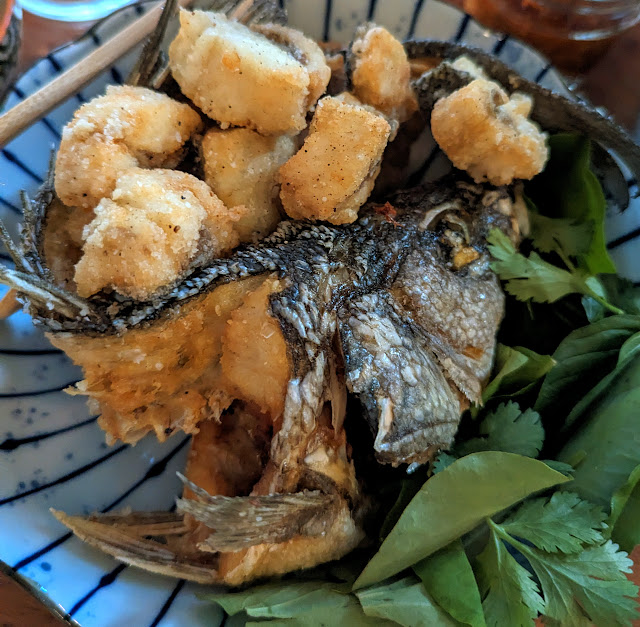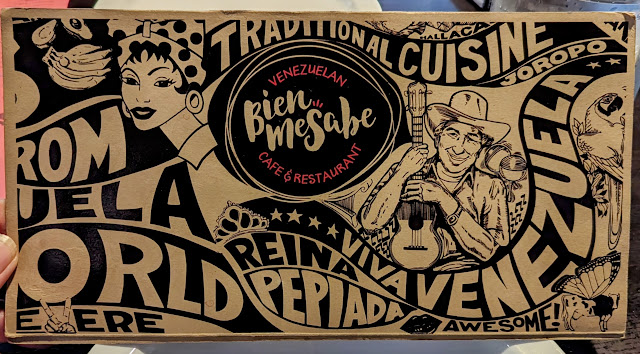Our first social engagement of the summer in the city - Chicago. Dinner with Todd & Evie and John & Stephanie at the fabulous Ethan Eang Lim restaurant - Hermosa. A new and wonder-filled menu. Loved the noodle dish, the soup 💕, the pork salad, the "bites" ( every one!). Actually there wasn't a single "lesser" course in the extensive menu. A terrific evening on all counts. We'll have to wait for Ethan to post the wines for the evening as I got not a single photo of the excellent assortment. We brought a 2014 St Aubin from Paul Pillot, a rose champagne, and a Clos des Andes (Argentina blend). Todd brought a great Pinot from Williams-Selyem and a fabulous California chard. The Blasers brought champagne (X2) and two dessert wines from Portugal. Nothing less than good, several great and pretty much all perfect pairings for the eclectic (for pairing purposes) menu.
Our first dinner back in Chicago was an Uber eats from the Thai place up the street (it was almost 8pm here, so 3am Sevilla time) Then, we had an early dinner at another "ethnic" (the "cuisine" we miss the most when in Spain) - Venezuelan. Bien Mesabe is exactly the neighborhood place we are always looking for. Good food and good service with a casual atmosphere and BYO policy (we were too off time zone to remember the wine - but hey...) To start we had shrimp tostones and empanadas. Then Phil has the churrasco arepa and I had the cachapa. No desserts, despite the Almond cake on offer, we were just too full....
Also this week I finished my Northwestern class on Children's Media Culture with Professor Jake Smith...an excellent nine week exploration of children in - as targets of - and as content producers of media.
When we consider the subject of children’s media culture, we quickly discern a host of
contradictory behaviors and attitudes: childhood is seen as a period of timeless wonder, but
children are bombarded with all the latest fads and gadgets; we try to insulate children from the
adult world, but provide them with media technologies that allow them easy access to it. This
class will explore contradictions such as these by exploring the history of children’s media. We
will discuss film adaptations of fairy tales and classic children’s literature; children’s television;
digital games; children’s music; and online video. Our case studies will allow us to engage with
debates about contemporary media culture and the nature of childhood. Children are often
understood to be a particularly vulnerable segment of the media audience, and children’s media
has much to tell us about media regulation and censorship, theories about media influence, and
the media’s role in education and marketing.
March 28 Media and the Construction of Childhood
We begin by thinking about the intersection of popular media and childhood: a crossroads that
has long inspired both beloved content and adult concern. Next, we encounter an argument about
the “social construction of childhood,” a conceptual framework that will structure our
consideration of a “modern” notion of childhood. Our case study this week is the film, Big
(1988), which shows how popular narratives might shed light on the history of childhood.
April 4 The Birth of the Children’s Audience: Fairy Tales and Classic Kid’s Lit
We begin our historical survey of children’s media by outlining some of the factors that
contributed to a “modern” notion of childhood. Our primary case studies are fairy tales and
books from the “golden age” of British children’s literature. Media adaptation provides a method
for gauging how notions of childhood change over time, and we examine several versions of
Lewis Carroll’s “Alice in Wonderland,” from the surreal to the spectacular.
April 11 The Child Movie Audience, Censorship, and the Rise of Disney
This week we encounter the concept of the “moral panic”: a recurring social dynamic in the
history of children’s media. Continuing our historical survey, we move to the 1910s and 1920s,
when the rise of a child audience for motion pictures spurred a moral panic that movies were
corrupting the nation’s youth. We’ll see how that panic helped to pave the way for Walt Disney,
and we’ll take Disney’s Pinocchio (1940) as our case study.
April 18 Postwar Kids Culture
The postwar era was marked by the Baby Boom and a dramatic shift in childrearing advice. This
provides us with an opportunity to consider how trends in childrearing literature shape media
practices in the home, a dynamic we can apply to more recent examples. With regards to the
postwar era, we examine the “Poet Laureate of Permissive Childrearing”: Dr. Seuss. We’ll talk
about Seuss’s little-known but fascinating The 5000 Fingers of Dr. T (1953). The postwar era
was also marked by a new medium – television – and a new moral panic about its relationship to
children.
May 2 Marketing to Children and “Home Alone” Kids
Television ushered in a new era of advertising directly to children. We examine concerns about
advertising to kids, the intersection of the toy industry and TV, and influential brands like Barbie
and GI Joe. We update this debate with a consideration of online “unboxing” videos. Our
historical survey moves to the 1980s and 1990s and the blockbuster Home Alone (1990) has
much to tell us about marketing to kids and a new kind of worldly-wise “latchkey kid.”
May 9 Media as Children’s Education
Television caused concern as a vehicle for advertising to kids, but it also held out the promise of
a new kind of media education. This week we investigate educational and prosocial media for
kids, with a focus on the history of PBS, the Children’s Television Workshop, and shows like
“Sesame Street,” “Mr. Roger’s Neighborhood,” and “Blues Clues.” We consider some of the
research on child development that shaped the style of these programs and compare a US and
UK model of children’s television.
May 16 Children’s Play and Videogames
We shift our focus from film and television to videogames, tracking the rise of videogames as a
form of popular entertainment and considering them in relation to theories of play. The history of
play spaces provides a new perspective on games like Pokemon and Minecraft, as well as the
multi-media LEGO franchise. The topics of children’s play and play space also bring up a host
of other related issues, including playground design, the “free range kids” parenting movement,
and concerns about “nature deficiency disorder” for media-saturated kids.
May 23 Meanings and Effects in Children’s Media; Revolutionary Childhood
This week we engage with one of the central debates about children and media: media violence
and its effects on children’s behaviour. We outline some of the main arguments and research
regarding media effects, as well as criticisms of that approach. We also examine an ideology of
“revolutionary childhood” in Soviet Russia and Communist China, and look at several media
depictions of child soldiers.
May 30 Kids Make Media
In our final session, we think about several ways in which children can be active participants in
their media culture. First, we examine the history of child actors, who present a fascinating
contradiction since they both embody the modern ideology of innocent childhood and go against
that same ideology by being professional child laborers. We’ll watch some examples of famous
child actors in action and discuss the particular characteristics of children as screen performers.
The documentary My Kid Could Paint That (2007) provides a fascinating case study. We also
think about kids as filmmakers – something that has become much more prevalent in the digital
era. Finally, we consider children’s rights legislation and how it might translate into the active
participation of children in media production.
so another term ends- and I am looking forward to the fall term with a new class with Nick Davis - another favorite professor.
So tonight and tomorrow we will actually eat at home and then Tuesday we are meeting Ron & Mary for dinner at Il Milanese... back into the swing of things....








































No comments:
Post a Comment